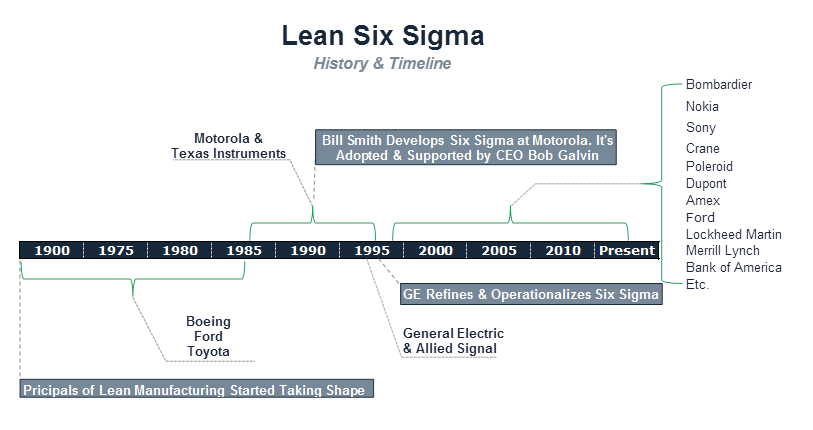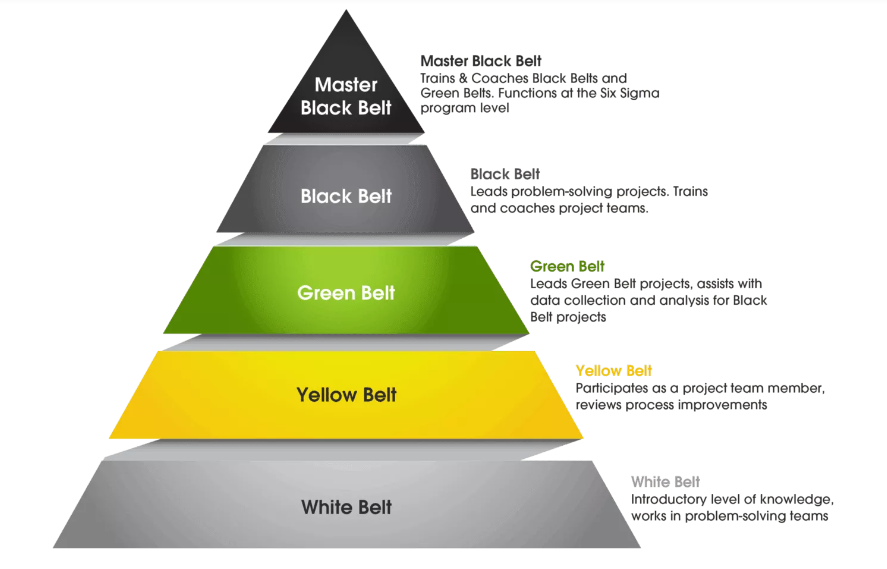Table of Contents
ToggleLean Six Sigma combines the process efficiency principles of Lean with the data-driven approach of Six Sigma to create a powerful methodology aimed at reducing waste, improving quality, and enhancing performance within an organization. Originating in the manufacturing industry, these methodologies have transcended their initial boundaries to benefit a wide array of sectors, including healthcare, finance, and IT.
Obtaining a Lean Six Sigma Yellow Belt Certification is the first significant step for professionals aiming to contribute effectively to such initiatives. It not only provides a solid foundation in these methodologies but also marks an individual’s commitment to advancing their career and the operational excellence of their workplace. Certified professionals often report a 20% improvement in performance and quality outcomes, highlighting the tangible impact of this certification on both personal and organizational growth. As such, the Yellow Belt serves not just as a symbol of knowledge, but as a beacon of potential within the continuous improvement landscape.
The Genesis of Lean Six Sigma
Lean Six Sigma is a methodology that marries two distinct philosophies of process improvement: Lean, which originated in Japan with Toyota’s production system aimed at waste reduction and efficiency, and Six Sigma, which Motorola developed in the United States as a data-driven method to reduce defects and improve quality. The fusion of these methodologies into Lean Six Sigma represents a synergistic evolution, harnessing the strengths of both approaches to form a comprehensive tool for business process improvement.
The journey toward this integration began in the late 1980s when forward-thinking businesses recognized that the rapid elimination of waste (Lean’s focus) and the meticulous reduction of process variations (Six Sigma’s aim) could produce superior results when combined. Pioneers like John Krafcik, who first coined the term “Lean” in a 1988 article, and Bill Smith, the “father” of Six Sigma at Motorola, laid the groundwork for this revolutionary idea. Mikel Harry, another key figure, played a crucial role in formalizing Six Sigma at Motorola and later advocated for integrating Lean principles to enhance Six Sigma’s framework.

Significant milestones in the development of Lean Six Sigma include the formal adoption of this combined approach by major corporations like General Electric and Honeywell in the mid-1990s, which not only validated the effectiveness of the methodology but also propelled it into mainstream business practices globally. This period marked the rapid evolution of Lean Six Sigma as a discipline, leading to its current status as an essential strategy for organizations aiming at process excellence and competitive advantage.
Understanding Lean Six Sigma Yellow Belt Certification
In the Lean Six Sigma hierarchy, the Yellow Belt plays a crucial foundational role. As the entry-level certification, Yellow Belts are trained to support process improvement projects by participating as team members and practicing the methodologies under the guidance of Green and Black Belts. Their primary responsibility is to apply basic Lean Six Sigma tools to improve efficiency, reduce waste, and contribute to projects with their problem-solving abilities.
Comparatively, Green Belts and Black Belts hold more advanced roles. Green Belts lead smaller projects or assist Black Belts in larger ones, having a deeper understanding of the methodology and stronger skills in statistical analysis. Black Belts manages major projects full-time, possesses extensive knowledge of Lean Six Sigma, and focuses on strategic implementation along with training and mentoring Green and Yellow Belts.

The Yellow Belt curriculum typically covers an introduction to the concepts of Lean and Six Sigma, including the basic tools and techniques used in the DMAIC (Define, Measure, Analyze, Improve, Control) process improvement framework. Key topics often include process mapping, cause and effect analysis, and basic statistical tools necessary for analyzing process data.
Several governing bodies offer Lean Six Sigma Yellow Belt certification, each with a slightly different emphasis in their training programs:
| Governing Body | Focus of Yellow Belt Training | Key Features |
|---|---|---|
| IASSC (International Association for Six Sigma Certification) | Broad overview of Lean Six Sigma principles | Emphasizes universal Lean Six Sigma knowledge without requiring a specific project for certification. |
| ASQ (American Society for Quality) | Practical application of Lean Six Sigma tools | Requires a completed project demonstrating real-world application of skills. Includes a comprehensive exam. |
| TUV-SUD | Integration of Lean and Six Sigma practices | Focuses on both methodology and practical implementation, including a project component for certification. |
These differences highlight the variety of approaches in Yellow Belt certification, allowing professionals to choose a program that best suits their learning style and professional needs. Each program aims to equip individuals with the necessary tools to begin their journey in process improvement and operational excellence. And Spoclearn can deliver all Lean Six Sigma Certification Training and other industry-recognized Quality Management Training programs globally.
The Road to Certification
Pursuing a Lean Six Sigma Yellow Belt certification is a structured journey that enhances one’s understanding of basic process improvement techniques and principles. Here’s a step-by-step guide to help you navigate the path to certification, along with the key prerequisites and an overview of certification bodies and their offerings.
Step-by-Step Guide to Yellow Belt Certification
- Understand the Basics: Familiarize yourself with the foundational concepts of Lean and Six Sigma. Online resources, introductory books, and preliminary workshops can be helpful.
- Choose a Certification Body: Decide which certification body aligns best with your career goals and learning preferences.
- Meet the Prerequisites: Ensure you meet any required prerequisites set by the certification body.
- Enroll in Training: Register for a Yellow Belt training program. This could be through in-person classes, online courses, or self-study materials.
- Complete the Coursework: Engage actively in the coursework, which typically includes lectures, readings, and practical exercises.
- Pass the Certification Exam: Prepare for and pass the certification exam, which may include multiple-choice questions and practical applications of Lean Six Sigma tools.
- Receive Certification: Upon successful completion of the exam, you’ll receive your Yellow Belt certification, marking your competency in the basics of Lean Six Sigma.
Eligibility Criteria and Offerings by Certification Body
Each certification body has its prerequisites and offerings for Yellow Belt certification. Here’s a comparison:
| Certification Body | Eligibility Criteria | Offerings |
|---|---|---|
| IASSC (International Association for Six Sigma Certification) | No specific prerequisites; open to all interested individuals | Exam-based certification without a project requirement. The exam covers all aspects of the Lean Six Sigma Yellow Belt Body of Knowledge. |
| ASQ (American Society for Quality) | No formal prerequisites, but prior knowledge of basic Lean Six Sigma principles is recommended | Certification requires passing a comprehensive exam that tests practical and theoretical knowledge. |
| TUV-SUD | Generally accessible, but some familiarity with Lean Six Sigma is beneficial | Focuses on integrating Lean and Six Sigma practices with an option to complete a project as part of the certification process. |
Special Focus: In-Depth Look at Lean Six Sigma Training
Lean Six Sigma Yellow Belt training is designed to provide a robust foundation in the methodologies that drive process improvement. This training encompasses a variety of modules, practical examples, and interactive learning methods to ensure participants can apply the principles effectively in their work environments.
Detailed Breakdown of Training Modules for Yellow Belts
- Introduction to Lean Six Sigma: Participants learn about the origins, principles, and goals of Lean and Six Sigma, including the importance of reducing waste and minimizing variability.
- The DMAIC Process: Detailed exploration of the Define, Measure, Analyze, Improve, and Control phases, which are critical to any Lean Six Sigma project.
- Basic Tools and Techniques: Training includes tools such as SIPOC diagrams (Suppliers, Inputs, Processes, Outputs, Customers), Pareto Charts, and Cause and Effect diagrams, which help in identifying the root causes of problems.
- Team Dynamics and Roles: Understanding the roles within a Lean Six Sigma project team and how to effectively contribute as a Yellow Belt.
Practical Examples of Concepts Taught During Training
- Define Phase Example: Participants might work through defining the scope of a process improvement project at a hypothetical company, setting clear objectives and project boundaries.
- Measure Phase Example: Learning how to collect and measure data using statistical tools on a simulated production line to establish current performance baselines.
Benefits of Engaging in Hands-on Project Work as Part of the Training
Hands-on projects allow participants to apply Lean Six Sigma tools in a controlled, risk-free environment. This practical application helps reinforce learning and demonstrates the real-world impact of simple improvements. Participants can see firsthand how modifying a process can lead to significant enhancements in productivity and quality.
Enhancement of Learning Through Virtual Simulations and Real-World Scenarios
Virtual simulations and real-world scenarios play a crucial role in Yellow Belt training. They provide a dynamic learning environment where participants can:
- Experiment with changes to see potential outcomes without real-world consequences, enhancing understanding and retention.
- Apply theoretical knowledge to simulated business scenarios, which helps bridge the gap between classroom learning and real-world application.
Career Impact of Yellow Belt Certification
Lean Six Sigma Yellow Belt certification offers both immediate and long-term benefits that can significantly enhance a professional’s career trajectory and workplace effectiveness. By acquiring this certification, individuals demonstrate a proactive commitment to improving their skill set and understanding of process improvement.
Immediate Benefits
- Enhanced Problem-Solving Skills: Yellow Belt training equips professionals with the tools to analyze and solve quality issues, enhancing their effectiveness on the job.
- Increased Visibility in the Workplace: Certified Yellow Belts often stand out in their roles, leading to greater recognition and potential for career advancement within their organizations.
Long-Term Career Benefits
- Broadened Career Opportunities: The skills acquired through Yellow Belt certification are applicable across a wide range of industries, opening up diverse career paths in areas such as operations, quality assurance, and project management.
- Foundational Step Towards Higher Certifications: The Yellow Belt is the stepping stone to more advanced Lean Six Sigma belts like Green and Black, which are associated with leadership roles and higher salary potential.
Testimonials and Case Studies
- A case study from a manufacturing company highlights a Yellow Belt who led a small team to reduce machine setup time by 30%, significantly boosting production efficiency and reducing costs.
- Testimonials from certified professionals often mention how Yellow Belt certification has made them a “go-to” person for solving process-related issues, enhancing their job security and professional growth.
By fostering an analytical mindset and a methodical approach to business problems, Yellow Belt certification not only enhances an individual’s employability but also positions them as a valuable asset to any organization aiming for continuous improvement and operational excellence.
Implementing Lean Six Sigma as a Yellow Belt
Lean Six Sigma Yellow Belt skills are versatile and applicable across various industries, from manufacturing to healthcare and finance. The fundamental tools and methodologies learned can be adapted to enhance processes, reduce waste, and improve quality.
Real-world Applications in Various Industries
- Manufacturing: Yellow Belts often work on projects to streamline production processes, thereby reducing defects and downtime.
- Healthcare: Implementing process improvements in patient flow and billing processes to reduce waiting times and minimize errors.
- Retail: Optimizing inventory management to reduce excess stock and improve the supply chain.
Common Challenges and Solutions
Yellow Belts may face several challenges, including resistance to change from team members and limited authority to implement changes. Effective communication and demonstrating small wins are crucial for overcoming these obstacles. Building a supportive coalition and aligning projects with organizational goals can also help mitigate resistance and increase project buy-in.
Success Stories
- A Yellow Belt in a logistics company successfully implemented a project to optimize route planning, resulting in a 20% reduction in fuel costs and improved delivery times.
- In a hospital setting, a Yellow Belt helped redesign the patient admission process, which decreased the average patient wait time by over 50%.
Beyond the Yellow Belt: Pathways to Further CertificationProgressing from a Yellow Belt to a Lean Six Sigma Green Belt and Lean Six Sigma Black Belt involves deeper learning and more significant responsibilities. Green Belts typically manage projects with a larger scope, requiring robust statistical analysis skills and a thorough understanding of Lean Six Sigma methodologies. Black Belts assume leadership roles, overseeing multiple projects and often mentoring Yellow and Green Belts. Further certification deepens expertise in process improvement and opens doors to senior management roles, consultancy opportunities, and specialized areas like quality control and operational excellence.

Conclusion
The Lean Six Sigma Yellow Belt Certification is more than just an educational achievement; it’s an essential investment in your professional development. This certification equips individuals with the tools to make meaningful improvements in their workplace, enhancing both efficiency and quality. The journey through Lean Six Sigma does not end with the Yellow Belt—it is merely the beginning. For those committed to personal and professional growth, advancing through further certifications can lead to transformative career opportunities and a lasting impact on any organization. Pursuing this path is not only a step toward personal mastery but also a contribution to the broader goals of any business seeking excellence and competitive advantage.
